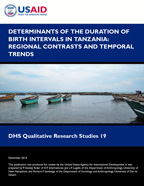- PUBLICATIONS
- JOURNAL ARTICLES
- ORDER PUBLICATIONS
Publications Summary
- Document Type
- Qualitative Research Studies
- Publication Topic(s)
- Family Planning
- Country(s)
- Tanzania
- Language
- English
- Recommended Citation
- Yoder, P. Stanley, Joe L.P. Lugalla, and Richard F. Sambaiga. 2013. Determinants of the Duration of Birth Intervals in Tanzania: Regional Contrasts and Temporal Trends. DHS Qualitative Research Studies No. 19. Calverton, Maryland, USA: ICF International.
- Download Citation
- RIS format / Text format / Endnote format
- Publication Date
- September 2013
- Publication ID
- QRS19
Download
 Determinants of the Duration of Birth Intervals in Tanzania: Regional Contrasts and Temporal Trends (PDF, 955K)
Determinants of the Duration of Birth Intervals in Tanzania: Regional Contrasts and Temporal Trends (PDF, 955K)
